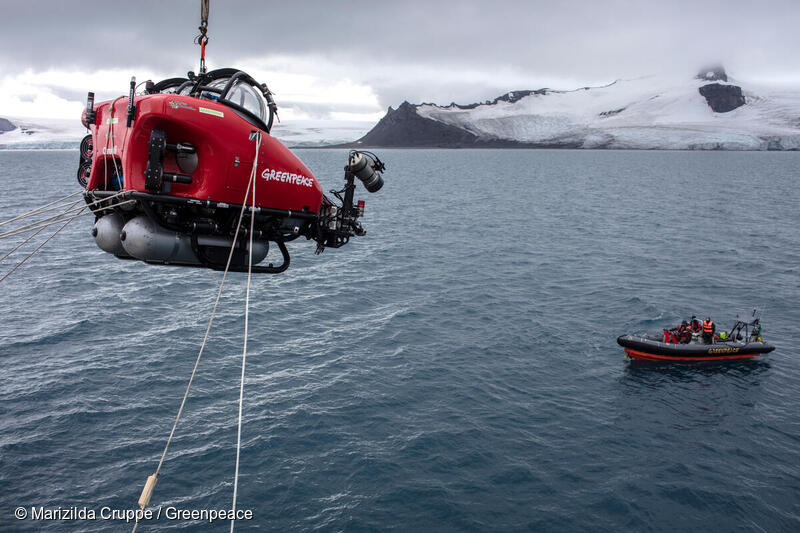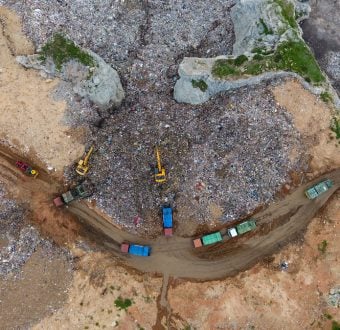As we are taught when we are kids, the ocean covers most of the surface of our planet.
But, of course, that is only the surface.
The oceans provide 99 percent of the living space. Most of the life on Earth lives beneath the waves, out of sight. How can you protect places that no one has ever seen from threats like industrial fishing, oil and gas drilling, or deep-sea mining? Sometimes, a submarine is the best way to show people what is at stake.
In 2017, several oil companies were preparing to drill off the coast of Brazil. Outside of a few environmentalists and local activists, there was very little controversy or even awareness about their plans. When Greenpeacers from around the world showed up in January with the Arctic Sunrise, a two-person DeepWorker submarine, and a team of Brazilian scientists, we knew we had very little time – the oil companies expected to begin drilling by March or April.
Instead, images of rare and beautiful creatures from the Amazon Reef were shared all over the world, helping galvanize a movement strong enough to stop Big Oil in its tracks. Five years later, drilling plans have largely been abandoned.
The same is true in the U.S. Arctic, where the Greenpeace ship The Esperanza brought a submarine to the site of Shell’s proposed drilling. We found large numbers of soft corals, which did not appear in Shell’s Environmental Impact Assessment. That added to the challenges Shell was already facing, and today the company’s hopes of drilling in the area seem very unlikely to come to pass.
It is hard to believe that it has been twelve years since the BP Deepwater Horizon disaster dumped over two hundred million gallons of oil into the Gulf of Mexico. The US government worked closely with BP to control access to the area, and to downplay the impact.
Greenpeace USA and others from our global network worked with scientists from over a dozen institutions to assess the true scope and impact of the spill on the Gulf ecosystem, and a submarine was a valuable tool to show what things looked like on the seafloor. We were relieved to see that the spill had not reached far enough to harm the spectacular cold-water coral reefs we visited, but another team working closer to the wellhead found a massive area that looked like an asphalt parking lot, with no living creatures in sight.
In 2018, we brought the DeepWorker sub to the Antarctic Peninsula. The Southern Ocean is a pretty challenging place to work, but we managed to pull off eight successful dives.
The corals and sponges we documented led to the designation of four new Vulnerable Marine Ecosystems, which are now closed to all fishing. The dives also helped policymakers realize the importance of ocean sanctuaries. If we found large numbers of fragile, habitat-forming creatures in half of our dives, how many more vulnerable areas must there be out there? We need to take a more precautionary approach, and part of that means setting aside large areas free from drilling or fishing that can help minimize the chances that humans break things at a scale that cannot be fixed.
The Greenpeace network’s first use of submarines was in the Bering Sea, where we were working to protect the world’s largest underwater canyons. The canyons were – and still are – ground zero for one of the largest fisheries on earth. Alaska pollock, a cod relative that are ground up by the millions and turned into fish sticks and McDonald’s sandwiches, are caught by massive factory trawlers that often drag their nets along the bottom.
When we suggested that this was a dangerous type of fishing to allow in the canyons, the fishing industry insisted that there was nothing down there but mud and silt. Of course, they knew better than that; bycatch records revealed that tons of corals and sponges were pulled up in their nets. But it took the work we did with submarines to force policymakers to even consider taking action.
This mix of science and public engagement has always been a part of the Greenpeace global network’s approach.
Using the Greenpeace ships to deploy submarines in areas at immediate risk from industrial activity is the kind of bearing witness our Quaker-inspired founders would understand. We cannot afford to use the subs everywhere, but if we are smart about picking our battles, they can be powerful tools to help people think differently about our oceans, and about the decisions, we make about how they should be used.



